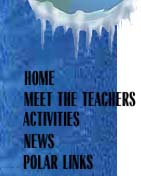
|
Teachers Experiencing Antarctica and the Arctic Might Be Right for You! Overview of the TEA Program The centerpiece of the Teachers Experiencing Antarctica and the Arctic (TEA) Program is a research experience in which a K-12 teacher parcticipates in a polar expedition. The TEA teacher works closely with scientists, parcticipates in cutting-edge research, and is immersed in the process of science. Enveloping this field experience is a diversity of professional development opportunities through which TEA teachers increase content knowledge, enhance teaching skills, transfer the experience to the classroom, assume leadership roles, and collaborate with a network of researchers and education colleagues. TEA is a partnership between teachers, researchers, students, the school district, and the community. TEA is sponsored by the Division of Elementary, Secondary, and Informal Education (ESIE) in the Directorate of Education and Human Resources (EHR) and the Office of Polar Programs (OPP) of the NSF and facilitated by Rice University, the Cold Regions Research and Engineering Laboratory (CRREL), and the American Museum of Natural History (AMNH).
Barb Schulz monitoring lake qualities in the Dry Valleys region during her field season in Antarctica.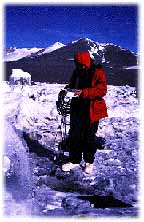
TEA Program Goals
Each TEA experience is an individual one. Through the network of the TEA Polar Learning Community, parcticipants leverage their experiences, build on their strengths, strengthen their weaknesses, and collaborate to bring their field-experience-inspired approach to science to their classrooms and community.
Tim Buckley (TEArctic 1995/1996) collecting an ice core in the Arctic.The Role of Research Experiences in Science Education Research experiences take the teacher and classroom beyond textbook science and even specific science content — research experiences capture the process of science through immersion in the field investigation. The National Science Education Standards emphasize the importance of providing inquiry based experiences for students, demonstrating that science is a human endeavor, and underscoring the relevance of science to society. Research experiences, such as TEA, are an opportunity for teachers to become immersed in the process of science and to share it with the classroom and community. In collaboration with science teachers, the TEA Program strives to:
Instituting change necessitates a long-term investment by all community members. Support in the form of access to resources, tools, training, and technology is necessary for leveraging learning and for transferring the experience to classrooms. Research Experiences are not solely about teachers and classrooms. The community includes researchers, teaching colleagues, administrators, students and the general public. There are benefits to all involved:
Jeremy Harris and Anna Klene probe the surface layers in the Toolik Lake study area to determine the depth of thaw.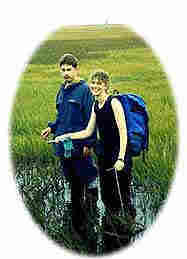
TEA Field Experience At the center of the TEA Program is a research experience in which a K-12 teacher parcticipates in a polar expedition. New TEA parcticipants attend an orientation at the CRREL where they become familiar with the TEA program, their responsibilities during and beyond the field experience, and the conditions and experiences they can anticipate during their work in the field. Prior to the field experience, TEA parcticipants spend two weeks at their research team’s institution to become familiar with the field technology and to acquire background information and knowledge of the research project. While in the field, TEA parcticipants are integral members of their polar research teams and assist in data collection and analysis. The Arctic field season extends approximately from March through September (some winter research also occurs); the TEA Arctic parcticipant spends 2 to 8 weeks in the field. The Antarctic season extends from October through March, with a 3 to 8 week field experience for the teacher. After returning from the field, the TEA teachers are encouraged to continue their collaboration with the research team. They may visit the research institution during the following year to complete the project, write-up their findings for journal arcticles, parcticipate in conference presentations, and involve their classrooms in the research.
Carole Bennett (TEA 1996/1997) talks with students eager to hear about her Antarctic adventures.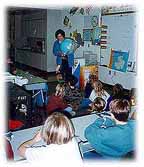
Connecting to Colleagues and Classrooms Because few teachers and students have the opportunity to venture to the polar regions and parcticipate in scientific research, one of the TEA teacher’s greatest responsibilities is to share the Antarctic/Arctic experience with others. While in the field, TEA teachers convey their experiences to classrooms through electronic field journals, electronic communications, and live Internet-based audio and video interaction. Once home, TEA parcticipants work with their school districts to bring their polar research experience into the classroom. TEA teachers develop classroom activities and materials based on their experiences and research. They mentor 3 peers and TEA Associate teachers to further engage peers and students in the process of science. TEA parcticipants present their experiences to the educational and scientific communities through their parcticipation in local and national meetings and workshops.
TEA parcticipant Responsibilities
*Specific dates will be determined by the research scientist’s scheduled time in the field and are not negotiable by the TEA teacher or the district.
Bruce Smith (TEA 1999/2000) caught an Antarctic Cod to study its antifreeze compoounds.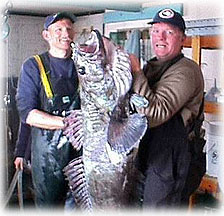
How do teachers get involved in TEA? There are two ways to be involved in TEA: TEA Associates Program Educators interested in bringing polar science into their classroom can join the TEA Associates Program TEA Associates collaborate with others in the Polar Learning Community to incorporate on-line journals and electronic communications into their classroom. Associates, TEAs, and researchers discuss current science topics and new discoveries, develop and test classroom materials, and identify and share polar resources and information. TEA Associates are encouraged to parcticipate in TEA Program events and to develop connections to other teachers, classrooms, and students. A limited number of travel grants to these events are available to TEA Associates. Information on how to become a TEA Associate is available on the TEA Web site at: join_assoc.html TEA Research Experience Program Teachers apply to accompany research expeditions in the research experience program. Applications deadlines occur once each year. The application can be requested at join_tea.html. Following completion of a short survey, you will be mailed an electronic version of the application.
How many teachers are involved each year in the research Experience? The number varies, depending on the funding level available to the program and the quality of applicants each year. Typically, 12 to 16 teachers are selected to parcticipate.
Sharon Harris (TEA 1999/2000) injects samples into the gas chromatograph injection port.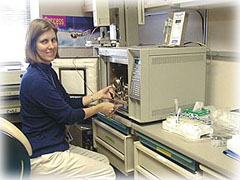
Do I have to have years of research experience or know a researcher to parcticipate? NO! TEA is a professional development program that encourages all teachers to apply. The TEA program is looking for teachers who desire to transfer research experiences into the classroom. This includes teachers with research experience, who demonstrate how they have leveraged these, and teachers who are interested in experimenting with new approaches to science education in their classroom. The application focuses on how your experiences have impacted your view of teaching, why you want to parcticipate in this program, how you will involve your classroom and the classrooms of others, and how you will involve your colleagues in your experience.
Who pays for a TEA teacher’s parcticipation in the program? The teacher remains on salary in their school district during their field experience. The NSF/ESIE/OPP covers teacher costs for a visit to the researcher’s institution, transportation and accommodations en route to the field site, the required medical examination, and a substitute teacher if needed. Cold weather gear is provided to TEA parcticipants on loan. ESIE provides funds for parcticipation in a variety of professional development meetings before and after the field experience.
How did the TEA program get started? TEA has its origins in the Young Scholars Program. Originally, high school students were selected to go to the Antarctic. Many of these students graduated, limiting their impact in the classroom in the following year. In 1992, several teachers parcticipated in an orientation workshop for the selected students. Knowing that one of the goals of the program was to transfer the experience into the classroom, the teachers suggested that they should also go to Antarctica. The teachers could maintain contact with other teachers, the students, and the community for an extended period of time. That year marks the initiation of the TEA program; five teachers headed south. The Arctic program began in 1995 with one teacher joining a research expedition. The following season three teachers parcticipated as members of Arctic research teams, solidifying the Arctic component of the TEA program. With the solidification of the TEA network, the emphasis on sharing this experience with the entire community increased. TEA is about sharing and collaborating within the TEA network and within an individual TEA’s community through activities development, mentoring, presentations, etc.
|
